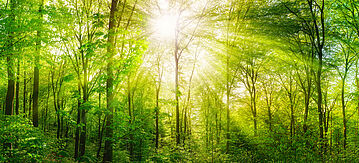Thuringian Forest wins acclaim in Indonesia
The doubling in size of the Thuringian Forest biosphere reserve received approval from the World Network of Biosphere Reserves (WNBR). The network now includes 686 UNESCO biosphere reserves in 122 countries. The UNESCO International Co-ordinating Council of Man and the Biosphere (MAB) held its annual meeting in Palembang, Indonesia, where it confirmed the German reserve’s fulfilment of strict criteria. At the meeting, the development of the reserve was also highlighted as a model for biosphere reserves worldwide. In total, the MAB council approved 24 new reserves around the world. Seven reserves lost their designation.
Inka Gnittke, chair of the German MAB National Committee at the Federal Environment Ministry, commented: “The resolutions taken by the co-ordinating council have considerably strengthened the global network of model regions for sustainable development. The participatory process in the Thuringian Forest reserve was held up as an international model. This shows that Germany is implementing the UNESCO Man and the Biosphere Programme in an exemplary way. Biosphere reserves are important for the implementation of the global 2030 Agenda for Sustainable Development. But we should also not forget – the reserves are beautiful parts of Germany as well.”
Background: Thuringian Forest biosphere reserve
The Thuringian Forest biosphere reserve is located near Ilmenau, Oberhof, Schleusingen, Suhl and Masserberg. A resolution was adopted doubling the size of the reserve to 337 square kilometres. A large part of the low mountainous region is covered by beech and spruce forest; there are meadows and pasture areas rich in biodiversity in the valleys. Rare species like the black stork and the fire salamander call the reserve home. A 25-kilometre stretch of the well-known Rennsteig long-distance hiking trail passes through the Thuringian Forest biosphere reserve, opening up the area for tourism. In a moderated participatory process lasting three years, reserve officials and stakeholders drew up a proposal to expand the reserve together with local authorities, businesses and citizens.
UNESCO Man and the Biosphere Programme (MAB)
UNESCO biosphere reserves show how the richness of natural and man-made landscapes can be preserved through sustainable economic use. In Germany, there are 16 UNESCO biosphere reserves, which, as model regions for sustainable development, are working together with 686 biosphere reserves worldwide. Strict nature conservation measures in core areas go together with the establishment and promotion of sustainable development practices in the majority of the reserve. In Germany, biosphere reserves receive around 65 million visitors annually, bringing in gross revenue of almost three billion euros.
The MAB International Co-ordinating Council takes annual decisions about the designation of biosphere reserves and, every ten years, reviews the quality of existing reserves. The council will continue its meeting in Palembang through Friday, deciding on the designation of additional biosphere reserves around the worl

